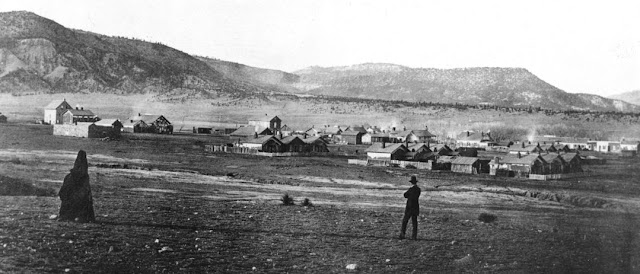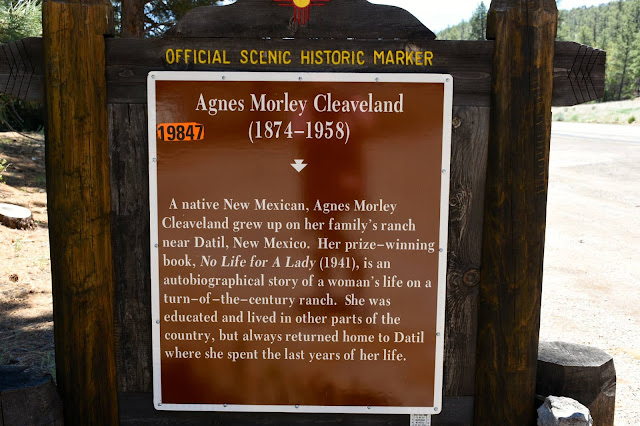 |
| Navajo Lodge interior photos April 1940 by Russell Lee* |
The original Morley home was built in 1885-86 from hand hewn logs cut in a nearby old growth forest. Ada raised Agnes, Ray and Lora in the big building called The White House** while sometimes hosting visitors who stayed weeks. Agnes describes construction of The Family's original home:
"Building our new house was itself an adventure. It began immediately after our arrival. The logs were felled on the nearby mountain-sides and dragged by ox teams to the site in the cañon bottom, itself eighty-three hundred feet above sea level. Four expert axemen – superb craftsmen - had been brought from Michigan logging camps to hew the logs. The original ten room house still stands, although, log by log, it has been moved to another site and enlarged, serving now as a tourist 'motel.' Its walls are true and plumb, with the axe marks scarcely visible; but if the logs could talk, and still remember the days when they were being snaked down the mountain by six yoke of oxen, poled by cowpunchers who hated themselves for doing it, I shudder to think what the ears of the present tourist might be subjected to." (Page 34 "No Life for a Lady)

Ada died at Magdalena in December 1917. We suspect the children didn't want to see their girl and boyhood home sit empty and forlorn in a such a lonely location. Ray apparently decided to move the house in 1920 to a Datil site alongside the Ocean-To-Ocean Highway. In 1926 W.W. Wheeler's words created a fond image of Navajo Lodge in the "Santa Fe New Mexican" newspaper:
"Datil, where Morley lives, is 30 miles from the end of a railroad spur at Magdalena and 60 miles west of the main line at Socorro. From Datil west it is 200 miles to the next railroad station. The post office and a store are located in one wing of Morley's home, Navajo Lodge. Except for three or four cabins, that is all of Datil. A transcontinental highway passes here. Navajo Lodge was or built by Morley a few years ago to serve the purposes of a home for himself and an inn for motorists. The big central room with its blazing fireplace, its fitting adornments of guns, saddles, hunting trophies and sport equipment, and with the host in his big chair entertaining the company with stories of cow camp and mines, make a picture no guest ever forgets. The floors and walls of the lodge display handsome Navajo rugs woven on the spot. A group of Navajo Indians camp across the road from the lodge each summer and put the raw wool of Morley's sheep through all the processes to the fully completed rugs. Some of the wool used by the Navajos comes from karakul sheep. Morley a few years ago established a flock of this breed and among other experiments has produced karakul fur, the highly valuable pelt from the newborn lambs."

We checked with experts at the Antique Automobile Club of America. The car closest to the photographer is a 1920 Model T sedan. The car beyond is a Dodge but the year hasn't been determined. So far, this is the oldest (earliest) postcard we've yet found of Navajo Lodge
Navajo Indians figure prominently in postcard views of Navajo Lodge
A casual Western motif is also common on the early postcards of Navajo Lodge.
The card above offers a rare glimpse of how the Navajo weavers were situated in relation to the Navajo Lodge.
Ray died in 1932 and Agnes continued to run Navajo Lodge until just before it burned to the ground in early January 1944. Although the original Morley Family Home was expanded during its tenure as Navajo Lodge, photos of the establishment help us better understand what the home was like during the Family's formative years as described in "No Life for a Lady."
To read the full story about the fire see:
https://www.newspapers.com/clip/98007305/fire-destroys-navajo-lodge-1944To read a truly wonderful three-page article by Agnes Morley Cleaveland about how they staged a rodeo to celebrate the New Navajo Lodge use the citation and link below. Note that you can get a free JSTOR account to read the article free of charge.
"Salt on the Tail of Yesterday"
by Agnes Morley Cleaveland
Southwest Review
Vol. 31, No. 3 (SUMMER 1946), pp. 251-253 (3 pages)
Published by: Southern Methodist University
End Notes:
*During the 1930's and 1940's The U.S. Farm Service Agency sent professional photographers across America to document rural land conditions, property and people.
Russell Lee was one such famous photographer. The U.S. Library of Congress has on file 18 photos Lee created showing exterior and interior of Navajo Lodge. Lee's photos give a priceless glimpse of what it might have been like when The Morley children came of age in that big house in the Datil Mountains.
We placed all of Lee's photo in a special Google album. We picked one photo of the front desk and downloaded a 144 megabyte file of it. We then created 13 views for a second Google photo album. They are located here:
Navajo Lodge
https://photos.app.goo.gl/LKpLwt7QK26aZVT59
Front desk
https://photos.app.goo.gl/xkJgpus32YgnmVCt6
Here is the link to find the original phhoto: Russell Lee 1940 FSA LOC
https://www.loc.gov/pictures/search/?q=datil&co=fsa
A note about the other photos. All other photos of Navajo Lodge came from eBay postcard listings. Simply search for "Datil New Mexico postcard" and you will generally find a mini-trove of old postcards of Navajo Lodge.
**The Mexican freighters gave the home its name "White House" because all of the window and door trim was painted white. The logs were unpainted. It became so well know that "White House Canyon" is now a permanent geographical place name for the area the house was located 10 miles from what's now Datil.








































